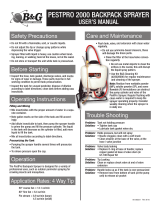
ENGLISH 4
3. Safety regulations
Correct use / Application
• This backpack sprayer must only be used for the
purpose of applying approved liquid pesticides,
insecticides, weed killer (herbicides) and liquid
fertilizers available from authorised specialist
dealers.
• Observe all instructions provided by the pesticide
manufacturer.
• This backpack sprayer must not be used to spray
any other media.
• We recommend only using pesticides that have
been approved for use by the relevant authorities
in your country.
• Never use fluids with a temperature in excess of
40°C.
• The backpack sprayer must not be used for any
other purposes, e.g. for the spraying of liquid paint.
• The backpack sprayer can be used for applications
in fruit farming, tree nurseries, forestry, vineyards,
vegetable growing and greenhouse cultivation
(subject to adequate ventilation).
Safe handling of spray pesticides
• Pesticides must never be allowed to enter public
sewer systems, sprayed onto wastelands, allowed
to drain into natural bodies of water or disposed of
together with normal domestic waste. This also
means that appropriate care must be taken during
filling to ensure that none of the pesticide is drawn
back into water pipes. Pesticides and any unused
leftovers of pesticides must always be collected in
a suitable container and disposed of via approved
facilities for household chemical waste. Please
contact your local authorities for information about
your nearest disposal facilities.
• Never eat, smoke or drink whilst working with
herbicides.
• Avoid any direct contact with pesticides.
• Stop working immediately if you start to feel unwell
while working, or if you become unusually tired.
Seek medical advice if the condition persists.
• Never allow children or anybody who is not familiar
with handling this type of spraying agent to handle
the spraying agent.
• Clean the solution tank whenever the spraying
agent is changed. Run the backpack sprayer with
clear water after cleaning the solution tank – but
before the next spraying agent is filled – flush out
any residue from the pump and the hoses. This will
prevent the risk of any chemical reactions taking
place between the different substances.
• Never spray in narrow or enclosed spaces –
pesticides are toxic and there is a risk of poisoning.
Spraying equipment must for example only be
used in greenhouses if adequate ventilation is
provided. Signs must be put up in greenhouses
that have been treated. Nobody should enter the
greenhouse again until it has been thoroughly
ventilated.
• When you have finished spraying, follow the steps
in section 13 "Draining and cleaning the solution
tank" to prepare the device for storage, thoroughly
wash your face and hands with soap, take off your
work clothing and ensure that it is washed regularly
Work clothing
When using this equipment, wear the prescribed
clothing and protective gear.
• Wear appropriate protective clothing which covers
all body parts. This includes gloves, head
protection, foot protection, body protection and
possibly an apron or breathing mask. Clothing
should suitable, i.e. tight without being obstructive.
Do not wear a scarf, necktie, jewellery or any
clothing which can get caught on shrubs or
branches.
• Wear firm shoes with good traction, preferably
safety shoes.
Wear protective gloves with non-slip grip.
Wear face protection (e.g. safety goggles)
against the sprayed substance.
When using spray medium that can be
hazardous to health, wear a breathing mask
to prevent poisoning.
• Immediately change any clothing that becomes
soaked with the spraying agent.
Always observe accident prevention regulations
issued by local trade organizations or workers
compensation boards.
Additional safety information regarding
application, cleaning and maintenance
• Do not operate the sprayer while persons
(especially children) or animals are in close vicinity.
The operator is responsible for any damage or
harm to third parties.
• Heavily dilute (approx. 1:10) surplus spray fluid left
over after treatment of field or garden, and spray
the solution over the area you have already treated.
• After every use and especially after the end of the
spraying season, clean and flush the sprayer, tank
as well as all parts which come in contact with
chemicals. Residues of plant protection chemicals
may lead to corrosion and damage of the sprayer.
Clean and service wear parts such as nozzles,
filters, gaskets and seals. We recommend the
SOLO horticultural equipment cleaner in 500 ml
bottles; part no. 49 00 600. Never clean nozzles
with hard objects.
• Damaged parts should be replaced without delay.
Always use Original Parts.
• Always release all pressure in the tank or spray line
before commencing service or maintenance work
on the machine.










